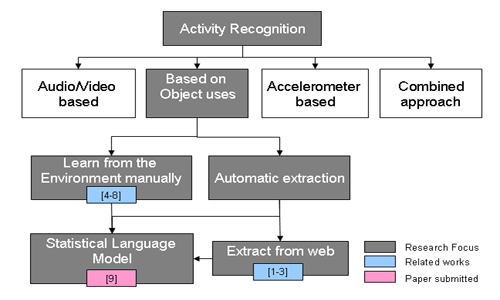Research summary of Jehad Sarkar
| |
|
| Goal and Applications |
- Recognition of Activities of Daily Living (ADL) through a stream of environmental sensor data in an unsupervised environment. Mine activity model from the web.
- There are thousands of activities. The system that uses supervised learning (human labeling) is not sufficient. We need activity model for this purpose. By activity model we mean the association between low level and high level activity and association between object uses and activity.
- A lot of web pages exists in WWW describe how to perform an activity, what object to use and how to use them. Our main research focus is to extract these directions in a meaningful way such that we can use these information to train our environmental sensor based classifier using RFID tag and reader.
- We are focusing on u-health care system.
|
| Methodology |
- Statistical Language Model (SLM) of Information Retrieval
- The purpose of statistical language modeling (SLM) is to improve the performance of various Natural Language (NL) applications by capturing regularities of NL. It estimates the probability distribution over a various linguistic units, such as words, sentences and whole documents.
- Our focus is to retrieve web pages from WWW, describe how to perform an activity and transform these into SLM. This model will serve as Activity model.
- In addition to this, we also intend to use SLM for ranking the activities based on the environmental sensor (sensors attached with daily appliances) such that improved accuracy can be achieved.
|
| Work flow |
|
| Research Taxonomy |
 |
| References |
- Perkowitz, M., Philipose, M., Fishkin, K., and Patterson, D. J. 2004. Mining models of human activities from the web. In Proceedings of the 13th international Conference on World Wide Web (New York, NY, USA, May 17 - 20, 2004). WWW '04. ACM, New York, NY, 573-582.
- Danny Wyatt, Matthai Philipose, and Tanzeem Choudhury. Unsupervised activity recognition using automatically mined common sense. In AAAI, pages 21--27, 2005. http://citeseer.ist.psu.edu/wyatt05unsupervised.html
- Building Reliable Activity Models Using Hierarchical Shrinkage and Mined Ontology (2006) by Emmanuel Munguia Tapia, Tanzeem Choudhury, Matthai Philipose in Proceedings of PERVASIVE 2006
- D. Patterson, L. Liao, D. Fox, H. Kautz, “Inferring High-Level Behavior from Low-Level Sensors,” Ubicomp 2003.
- D. J. Patterson, D. Fox, H. Kautz, and M. Philipose. Fine-grained activity recognition by aggregating abstract object usage. iswc, 0:44–51, 2005.
- M. Philipose, K. Fishkin, D. Fox, D. Hahnel, and W. Burgard. Mapping and localization with rfid technology, 2003.
- E. M. Tapia, S. S. Intille, and K. Larson. Activity recognition in the home using simple and ubiquitous sensors. In Ferscha and Mattern [11], pages 158–175.
- C. R. Wren and E. M. Tapia. Toward scalable activity recognition for sensor networks. In LoCA, pages 168–185, 2006.
- Jehad Sarkar, Young-Koo Lee and Sungyoung Lee,. Statistical Language Modeling Approach to Activity Recognition. Submitted to the International Conference on Consumer Electronics (ICCE), 2009.
|
|
|
| :: UC Lab News |
06-21-2008
Each team leaders(SCOME team NQ Hung, AR team: Jehad, uSEC team: Riaz) must write down the proposal based on the sending template.
Each team leaders will present a draft version of revised DISCCO project proposal on July 5.
|
 |
06-24-2008
New website launched by Activity Recognition team...
|
|

